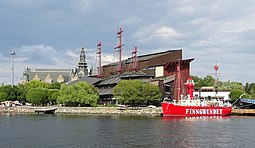Vasa Museum
 Exterior view of the Vasa Museum (2018) |
|
| Data | |
|---|---|
| place | Stockholm |
| architect | Månsson & Dahlbäck |
| opening | June 15, 1990 |
| Number of visitors (annually) | 1.5 million (2017) |
| management |
Marika Hedin
|
| Website | |
The Vasa Museum ( Swedish Vasamuseet ) is a maritime museum in Stockholm , Sweden . It is located on the island of Djurgården and shows the almost completely preserved warship Vasa , which sank on its maiden voyage in 1628, as well as its history.
The museum was opened in 1990, belongs to the association Statens maritima museer ( German State Maritime Museums in Sweden ) and is the most visited museum in Scandinavia .
history
From 1961 to 1988 the Vasa was temporarily housed in the Wasavarvet (Vasa shipyard) and treated with polyethylene glycol for preservation . The Swedish government decided in 1981 to build an independent Vasa Museum and organized an architecture competition , the final winners of which, Marianne Dahlbäck and Göran Månsson, prevailed against a total of 384 models submitted. Construction of the new building was carried out around a dry dock of an old shipyard and began on November 2, 1987 with a ceremony attended by Prince Bertil . In December 1988 the Vasa was pulled into the flooded dry dock under the half-finished building and in the summer of 1989, when visitors were already allowed to enter the construction site, 228,000 interested people were counted.
The museum opened on June 15, 1990. The construction costs amounted to over 200 million crowns . So far, the Vasa has been seen by over 25 million people. With 1,495,760 visitors, the 2017 exhibition replaced Skansen as the most visited museum in the country.
exhibition
In the 34 m high main hall, in addition to the vasa, various archaeological finds of ships and objects from the early 17th century are on display. The ship is completely housed in the building, including the lower mast sections , bowsprit and rigging . Missing or badly damaged parts were replaced, but not treated or painted, so that they stand out clearly from the original parts, which darkened in the water over the centuries. According to the museum, 98% of the ship are original parts and only 2% are added or replaced after salvage. The ship can be viewed from six levels, from the keel to the end of the aft fort . Various objects and models are exhibited all around, illustrating the construction, finding and restoration of the vasa . There are also many exhibits on the history of Sweden in the 17th century, which provide background information that led to the construction of the ship. The museum has 12,540 m 2 of exhibition space.
The museum ships belonging to the Seehistorisches Museum are located in a harbor in front of the museum:
- Icebreaker Sankt Erik (commissioned 1915)
- Lightvessel Finngrundet (1903)
- Speedboat Spica (1966)
- Lifeboat Bernhard Ingelsson (1944)
The book Vasa I: The Archeology of a Swedish Warship from 1628 was published in 2006. The following volumes are presented annually.
architecture
The new museum is dominated by a large copper roof with stylized masts that are supposed to show the original rig height of the Vasa . Parts of the building are covered with colored wooden panels.
Illustrations
See also
literature
- Lars-Åke Kvarning, Bengt Ohrelius: The Vasa - The Royal Ship. 1998, ISBN 91-7486-581-1 .
Web links
- Official website (German)
- 2008 Annual Report of the State Maritime Museums (PDF - Swedish; 1.9 MB)
Individual evidence
- ↑ a b Vasamuseet, Skansen och Naturhistoriska drog mest besökare. SVT Nyheter, January 11, 2018, accessed November 14, 2019 (Swedish).
- ↑ Lars-Åke Kvarning, Bengt Ohrelius: The Vasa - The Royal Ship. Pp. 163-173.
- ↑ a b Homepage of the Vasa Museum. Retrieved June 7, 2013 (Swedish).
- ↑ How much of Vasa is original? - The Ship - Customer Support Forum - The Vasa Museum. Retrieved June 15, 2018 .
Coordinates: 59 ° 19 ′ 40 ″ N , 18 ° 5 ′ 28 ″ E





